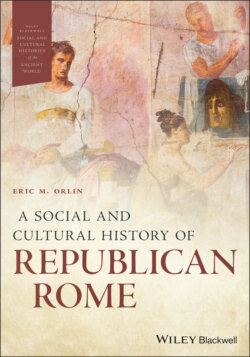Читать книгу A Social and Cultural History of Republican Rome - Группа авторов - Страница 10
Timeline of Roman History
ОглавлениеParentheses indicate an approximate date
| Period | Date | Military | Political | Social | Cultural | Religious |
|---|---|---|---|---|---|---|
| Monarchy | 753 BCE | Traditional date for Foundation of City of Rome | (Romulus creates patricians, plebeians, and patron–client relationships) | (Cult of Hercules arrives in Rome) | ||
| Early Republic | 509 | Traditional date for Foundation of Roman Republic | Etruscan terracotta statues | Temple of Jupiter Capitolinus | ||
| 494 | Local skirmishes | Traditional date for First Secession of Plebs | Struggle of Orders (Traditional dates 494–287 BCE) | Temple of Castor and Pollux | ||
| 451–50 | Twelve Tables written | |||||
| 431 | Temple of Apollo | |||||
| 396 | Conquest of Veii | Evocatio of Juno Regina | ||||
| 390 | Gallic Sack of Rome | Destruction (?) of City | ||||
| 367 | Creation of praetor | Plebeians eligible for consulship | (Construction of “Servian” wall) | |||
| 341-338 | War vs. Latin League | Settlement of 338 | (Manipular Organization of Army) | |||
| 326 | Abolition of Nexum slavery | |||||
| 312 | Aqua Appia and Via Appia constructed | |||||
| 304 | Publication of legis actio | |||||
| 290 | Conquest of Samnium complete | (Capitoline Brutus) | Temple C of Largo Argentina | |||
| Middle Republic | 280–275 | Wars vs. Pyrrhus in S. Italy | (Introduction of Roman coinage) | |||
| 270 | Death of Scipio Barbatus | |||||
| 264–241 | First Punic War | (Livius Andronicus) | ||||
| 218–202 | Second Punic War | |||||
| 218 | Hannibal crosses Alps into Italy | |||||
| 216 | Hannibal destroys 100 000 Roman soldiers | (Naevius) | ||||
| 212 | Marcellus brings Greek art from Sicily | |||||
| 204 | (Fabius Pictor) | Magna Mater brought to Rome | ||||
| 202 | Scipio invades N. Africa; victory over Carthage | (Plautus) | ||||
| 200–146 | Conquest of Greece and Asia Minor | (Massive Influx of enslaved persons) | (development of formulary procedure) | |||
| 195 | Repeal of lex Oppia | (Ennius) | ||||
| 186 | (Terence) | Bacchanalia incident | ||||
| 184 | Censorship of Cato the Elder | Basilica Porcia | ||||
| 177 | Italian recruitment difficulties | |||||
| 171 | Spurius Ligustinus | |||||
| 169 | lex Voconia | |||||
| 167 | Victory in Greece | Triumph of Aemilius Paullus | Polybius arrives in Rome | |||
| 161 | lex Fannia sumptuary legislation | |||||
| 160 | (Cornelia raises the Gracchi brothers) | (Cato’s On Agriculture) | ||||
| 154 | Stone theater in Rome destroyed | |||||
| 149 | Creation of first permanent court | |||||
| 149–146 | Third Punic War | |||||
| 147 | First marble temple in Rome | |||||
| 146 | Destruction of Carthage and Corinth | |||||
| 139 | Introduction of Secret Ballot | (Lucilius) | ||||
| Late Republic | 133 | Tiberius Gracchus | ||||
| 122 | Gaius Gracchus | (Tombstone of Claudia) | ||||
| 107 | (Army reforms) | First consulship of Marius | ||||
| 104 | First election for Pontifex maximus | |||||
| 91–89 | Social War | Italians gain full citizenship | (Jurist Mucius Scaevola) | |||
| 88 | War vs. Mithridates | Sulla marches on Rome | Massacre of Italians in Asia | |||
| 82–79 | Sulla’s dictatorship | Cicero and Terentia marry | (Appearance of Dressel amphorae) | |||
| 80 | First surviving amphitheater at Pompeii | |||||
| 70 | Cicero’s prosecution of Verres | (Veristic portraits, e.g. statue of general from Tivoli) | ||||
| 67–63 | Pompey the Great conquers East | |||||
| 60 | “First Triumvirate” formed | (Catullus) | ||||
| 59 | Caesar’s Campaigns in Gaul | Consulship of Julius Caesar | Pompey marries Julia | |||
| 55 | Theater of Pompey built | |||||
| 53 | Tiro gains free status | (Cicero) | ||||
| 49 | Civil War between Pompey and Caesar | Caesar crosses Rubicon | ||||
| 48–44 | Dictatorship of Caesar | |||||
| 46 | Cicero and Terentia divorce | Dedication of Forum of Caesar | ||||
| 45 | Death of Tullia | |||||
| 44 | Caesar assassinated | Caesar deified after his death | ||||
| 31 | Battle of Actium | |||||
| 27 | Octavian becomes Augustus, first Roman Emperor | |||||
| 25 | Livy publishes first five books of history | |||||
| 20 | (Horace, Ovid, Sulpicia active) | |||||
| 19 BCE | Vergil dies; Aeneid published after death | |||||
| 79 CE | Eruption of Vesuvius buries Pompeii | |||||
| 450 | (Oldest surviving manuscript of Terence) | |||||
| 529 | Justinian’s Digest published | |||||
| 1748 | Rediscovery of Pompeii | |||||
| 1764 | Winckelmann argues that white statuary is ideal | |||||
| 1789 | Authors of Federalist Papers use Roman pseudonyms | |||||
| 2020 | White supremacists deploy SPQR as symbol |
